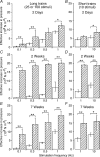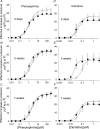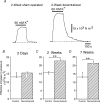Chronic decentralization potentiates neurovascular transmission in the isolated rat tail artery, mimicking the effects of spinal transection
- PMID: 15486013
- PMCID: PMC1665372
- DOI: 10.1113/jphysiol.2004.074948
Chronic decentralization potentiates neurovascular transmission in the isolated rat tail artery, mimicking the effects of spinal transection
Abstract
Spinal cord transection produces a marked increase in the response of the isolated rat tail artery to sympathetic nerve stimulation, possibly as a result of a decrease in ongoing sympathetic activity. We have tested the effects of removing ongoing nerve activity on neurovascular transmission by cutting the preganglionic input to postganglionic neurones supplying the tail artery (decentralization). Isometric contractions to nerve stimulation were compared between decentralized arteries and those from age-matched and sham-operated controls. Nerve-evoked responses of decentralized arteries were much larger than those of control arteries at 2 and 7 weeks post operatively. The extent of blockade of nerve-evoked contraction by alpha-adrenoceptor antagonists prazosin (10 nM) or idazoxan (0.1 microM) was reduced. Decentralized arteries were transiently supersensitive to the alpha1-adrenoceptor agonist phenylephrine and the alpha2-adrenoceptor agonist clonidine; the unchanged sensitivity to methoxamine and phenylephrine after 2 weeks indicated no effect on the neuronal noradrenaline uptake transporter. Decentralized arteries were hypersensitive to alpha,beta methylene-ATP, but the P2-purinoceptor antagonist suramin (0.1 mM) did not reduce nerve-evoked contractions. Enlarged responses to 60 mM K+ after both 2 and 7 weeks were correlated with the response of the arteries to nerve stimulation, suggesting that increased postjunctional reactivity contributes to the enhanced contraction. Comparison between data from decentralized arteries and our previous data from spinalized animals showed that the two lesions similarly potentiate nerve-evoked contractions and have similar but not identical postjunctional effects. The enhanced vascular responses following a reduction in tonic nerve activity may contribute to the hypertensive episodes of autonomic dysreflexia in spinally injured patients.
Figures







Similar articles
-
Tail arteries from chronically spinalized rats have potentiated responses to nerve stimulation in vitro.J Physiol. 2004 Apr 15;556(Pt 2):545-55. doi: 10.1113/jphysiol.2003.056424. Epub 2004 Feb 6. J Physiol. 2004. PMID: 14766944 Free PMC article.
-
Sympathetic vasoconstriction is potentiated in arteries caudal but not rostral to a spinal cord transection in rats.J Neurotrauma. 2010 Nov;27(11):2077-89. doi: 10.1089/neu.2010.1468. J Neurotrauma. 2010. PMID: 20822463
-
Enhanced neurally evoked responses and inhibition of norepinephrine reuptake in rat mesenteric arteries after spinal transection.Am J Physiol Heart Circ Physiol. 2006 Jan;290(1):H398-405. doi: 10.1152/ajpheart.00712.2005. Epub 2005 Sep 2. Am J Physiol Heart Circ Physiol. 2006. PMID: 16143650
-
Adaptations of peripheral vasoconstrictor pathways after spinal cord injury.Prog Brain Res. 2006;152:289-97. doi: 10.1016/S0079-6123(05)52019-3. Prog Brain Res. 2006. PMID: 16198708 Review.
-
Changes in sympathetic neurovascular function following spinal cord injury.Auton Neurosci. 2018 Jan;209:25-36. doi: 10.1016/j.autneu.2017.02.003. Epub 2017 Feb 11. Auton Neurosci. 2018. PMID: 28209424 Review.
Cited by
-
Somatosympathetic Vasoconstrictor Reflexes in Human Spinal Cord Injury: Responses to Innocuous and Noxious Sensory Stimulation below Lesion.Front Physiol. 2012 Jun 25;3:215. doi: 10.3389/fphys.2012.00215. eCollection 2012. Front Physiol. 2012. PMID: 22737131 Free PMC article.
-
Modified cytoplasmic Ca2+ sequestration contributes to spinal cord injury-induced augmentation of nerve-evoked contractions in the rat tail artery.PLoS One. 2014 Oct 28;9(10):e111804. doi: 10.1371/journal.pone.0111804. eCollection 2014. PLoS One. 2014. PMID: 25350563 Free PMC article.
-
Diversity of sympathetic vasoconstrictor pathways and their plasticity after spinal cord injury.Clin Auton Res. 2007 Feb;17(1):6-12. doi: 10.1007/s10286-006-0394-8. Epub 2007 Jan 30. Clin Auton Res. 2007. PMID: 17264977 Free PMC article. Review.
-
Rho kinase inhibitors reduce neurally evoked contraction of the rat tail artery in vitro.Br J Pharmacol. 2005 Nov;146(6):854-61. doi: 10.1038/sj.bjp.0706377. Br J Pharmacol. 2005. PMID: 16113686 Free PMC article.
-
Transient supersensitivity to alpha-adrenoceptor agonists, and distinct hyper-reactivity to vasopressin and angiotensin II after denervation of rat tail artery.Br J Pharmacol. 2010 Jan;159(1):142-53. doi: 10.1111/j.1476-5381.2009.00520.x. Epub 2009 Dec 4. Br J Pharmacol. 2010. PMID: 20002103 Free PMC article.
References
-
- Abe K, Matsuki N, Kasuya Y. Pharmacological and electrophysiological discrimination of contractile responses to selective α1- and α2-adrenoceptor agonists in rat tail artery. Jpn J Pharmacol. 1987;45:249–261. - PubMed
-
- Bao JX, Gonon F, Stjärne L. Frequency- and train length-dependent variation in the roles of postjunctional α1- and α2-adrenoceptors for the field stimulation-induced neurogenic contraction of rat tail artery. Naunyn Schmiedebergs Arch Pharmacol. 1993;347:601–616. - PubMed
-
- Bradley E, Law A, Bell D, Johnson CD. EfVects of varying impulse number on cotramsmitter contributions to sympatketic vasoconstriction in rat tail artery. Am J Physiol Heart Circ Physiol. 2003;284:H2007–2014. - PubMed
Publication types
MeSH terms
Substances
LinkOut - more resources
Full Text Sources
Medical

